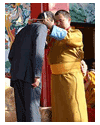 Kalmykia, Russia -- In the early days of October, Kalmykia celebrated the tenth opening anniversary of the republic’s first Buddhist monastery: Geden Sheddup Choikorling. Considering the very rapid pace of development of Buddhist teaching in the steppe republic, this celebration has in some way become a new milepost, on the one hand allowing for a backward glance and on the other a look forward to the new day.
Kalmykia, Russia -- In the early days of October, Kalmykia celebrated the tenth opening anniversary of the republic’s first Buddhist monastery: Geden Sheddup Choikorling. Considering the very rapid pace of development of Buddhist teaching in the steppe republic, this celebration has in some way become a new milepost, on the one hand allowing for a backward glance and on the other a look forward to the new day.
Kalmykia made the revitalization of Tibetan Buddhism a high-priority for regional development, and can now offer Buddhist Russia a well substantiated hope for resolving a great diversity of burning issues. First, among all Russian Buddhist Republics only Kalmykia was able to stage (even if only a most brief) visit by the Dalai Lama in November of 2004.
Tuva and Buriatia are still forced to speak of a fourteen year lapse since the last close contact with their spiritual leader, who should ideally guide Buddhism’s future spiritual development. Second, the changes coming on the heels of the one-day 2004 visit could be stunning not only a Buddhist from Buriatia or Tuva, but any non-Buddhist from any economically developed location on the planet’s surface.
The Temple of the Golden Abode of Buddha Shakyamuni, built in nine months, in the very center of the Kalmyk republican capital Elista, became the material manifestation of the strength of the Dalai Lama’s blessing, and the good intentions of his Kalmyk followers, among whom a special place is held by the republic’s supreme lama Telo Tulku Rinpoche and the head of Kalmykia, Kirsan Ilyumzhinov.
Their cooperation and devotion to His Holiness the Dalai Lama are likely the major reason to view the future of Buddhism in Russia with a certain dose of optimism.
Gold Medals from Telo Tulku Rinpoche
Geden Sheddup Choikorling monastery opened to great fanfare on October 5, 1996. “On that day, forty to fifty thousand people gathered together, sincerely hoping for an impending rebirth of the almost lost Buddhist culture and religion.” remembers Tashi, the representative of His Holiness the Dalai Lama in Russia, Mongolia and the Commonwealth of Independent States. “At that time maybe three of four temples had been built in Kalmykia, today there are over thirty.”
The supreme lama of Kalmykia, Telo Tulku Rinpoche, considers this a very significant achievement. “In the twelve to thirteen years since the beginning of the spiritual revival, we reached better results that those of which even the wealthy countries can speak,” he says. “Look at Kalmykia, a small country with a population of 300 thousand people. Truly such rapid development is the source of incredible inspiration not only for the Kalmyk people, but the whole world.” Even America has not managed to build thirty-three Buddhist monasteries in twelve years,” he adds with a smile.
It was in America itself, in a family of Kalmyk émigrés that the future head lama of Kalmykia was born. At the suggestion of His Holiness the Dalai Lama, his parents took the six-year-old boy, even then interested in monastic life, to the Tibetan Drepung Gomang monastery, rebuilt in India.
“Among Buriat lamas, legends about a little Kalmyk boy who came to Drepung Gomang with his parents, and expressed a desire to remain at the monastery were circulating back then. Later the Dalai Lama recognized him as the incarnation of Tilopa. In his past incarnation he had been a great Mongol lama,” recalls Choi Dorjee Budaiev.
First finding himself in Kalmykia in 1991, Telo Tulku Rinpoche was soon elected the supreme lama of the steppe Buddhist republic. The difficult years preced